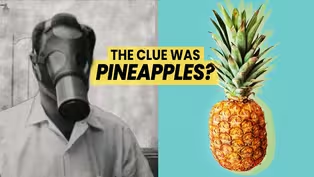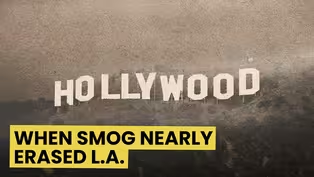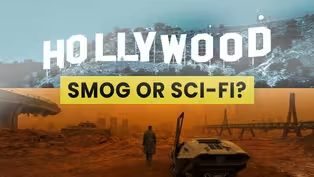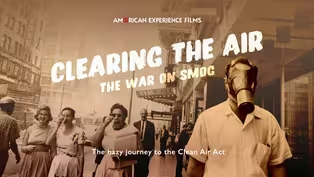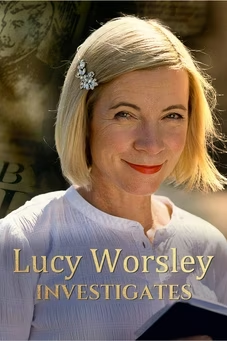
Chapter 1 | Clearing the Air: The War on Smog
Clip: Season 37 Episode 4 | 8m 41sVideo has Closed Captions
Watch a preview of Clearing the Air: The War on Smog.
Watch a preview of Clearing the Air: The War on Smog.
Problems playing video? | Closed Captioning Feedback
Problems playing video? | Closed Captioning Feedback
Corporate sponsorship for American Experience is provided by Liberty Mutual Insurance and Carlisle Companies. Major funding by the Alfred P. Sloan Foundation.

Chapter 1 | Clearing the Air: The War on Smog
Clip: Season 37 Episode 4 | 8m 41sVideo has Closed Captions
Watch a preview of Clearing the Air: The War on Smog.
Problems playing video? | Closed Captioning Feedback
How to Watch American Experience
American Experience is available to stream on pbs.org and the free PBS App, available on iPhone, Apple TV, Android TV, Android smartphones, Amazon Fire TV, Amazon Fire Tablet, Roku, Samsung Smart TV, and Vizio.
Buy Now
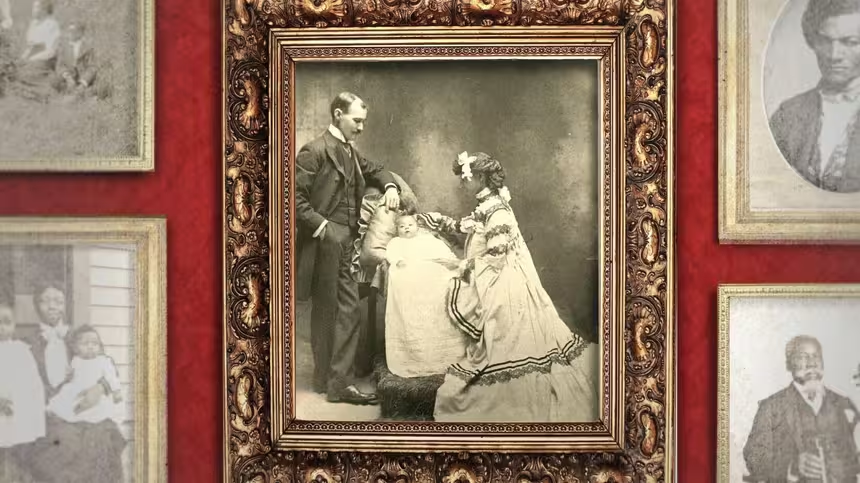
When is a photo an act of resistance?
For families that just decades earlier were torn apart by chattel slavery, being photographed together was proof of their resilience.Providing Support for PBS.org
Learn Moreabout PBS online sponsorship♪ ♪ CHIP JACOBS: It's hard for us to imagine what it was like that day in July 1943.
It appeared quite suddenly.
CHRIS WELLS: Thick, dark, silvery-blue clouds descended over the city of Los Angeles.
People couldn't see across the street.
They were wondering what was going on.
ANN CARLSON: It was basically gas everywhere and you couldn't see more than a couple of blocks.
You couldn't see the buildings of downtown Los Angeles.
It was so bad that cars crashed, because you couldn't see the cars in front of you.
JACOBS: The "L.A. Times" would later call it a "Daylight Dim-out."
Sort of like a chemical eclipse happened.
It was like a dirty blanket thrown across the sky.
MUSTAFA SANTIAGO ALI: When folks came out of their house, their eyes began to sting, their throats began to burn, and they were trying to figure out, "Why is it that I can't breathe?"
♪ ♪ WELLS: There were lots of theories.
People thought that it might be a chemical attack by the Japanese.
This was in the middle of World War II.
There had actually been U-boat attacks on Santa Barbara, where submarines were shelling the oil fields.
It really freaked people out.
JACOBS: But within a few weeks, it was abundantly clear it wasn't the Japanese, it wasn't some German plot.
It was coming from within.
ALI: Residents had no idea, local governments had no idea what it was.
CARLSON: The solutions to the mystery would prove extraordinarily complicated and take decades of work.
♪ ♪ AFTON SLADE: We'd do some rather wild demonstrations with little children in gas masks.
We're tired of double-talk.
We're tired of mumbo-jumbo language.
JACOBS: It would revolutionize the auto industry.
A high school student would recognize this as a conspiracy.
MERLIN CHOWKWANYUN: It would bring together people from all kinds of ideological stripes with a common civic commitment to a common civic goal.
RONALD REAGAN: My fellow Californians, today, we lead the nation in the battle for cleaner air.
CARLSON: "We're going to set these standards "based on what's safe for the public, not on what's convenient for you to do."
RICHARD NIXON: The lives we spend in the future are going to be pollution-free.
MARY NICHOLS: What began in the Los Angeles of the 1940s and '50s would have a tremendous effect on the quality of air that we all breathe to this day.
(engine starts) FILM NARRATOR: In the years since the turn of the century, Los Angeles has grown from a sleepy pueblo to a vast, seething metropolitan city.
Fine buildings, huge stores, busy citizens.
A city which has grown faster than any other in America in the past decade and which sees a constant day-to-day influx of people from every part of the world.
CHOWKWANYUN: In the early 1940s, people are coming to Los Angeles for all kinds of reasons.
If there's one word people think about with Los Angeles during this time period, it's "boom."
In the 1940s, Los Angeles was Shangri-la.
It was a place where everybody wanted to go because of the beaches.
Movie stars.
(car horns honking) Hollywood.
(crowd cheering) WELLS: It also had a reputation as being a healthy place, and a number of people moved there specifically to take advantage of the beautiful weather.
FILM NARRATOR: Climate here is as close to perfect as it can be anywhere on Earth.
And, once here, the newcomer would rather be here than anywhere else.
The population tripled between 1920 and 1940.
Then it even almost doubled between 1940 and 1950.
ALI: We often see this golden sort of aura around Los Angeles in the 1940s.
But it doesn't have any real meaning if you have to wear a gas mask to walk down the street.
MAN: I've been a resident of this city for 12 years.
And brother, I can't take it anymore.
JACOBS: In 1943, there was a giant attack of air pollution, and people fled.
People freaked.
It was just the beginning of a generational nightmare.
Kids were told they couldn't play outside the schools.
This sort of a gray pall cast over the air.
The Los Angeles International Airport shut down because pilots couldn't see the runway, and it wasn't safe to fly.
People wheezing, people not being able to see clearly, to breathe clearly.
(car horns honking) No one knew what was going on.
People ended up in the hospital.
And the idea that living with air pollution was just L.A.'s future was not tolerable to people.
If this keeps up, I'm going to leave California for the sake of my children and myself.
ALI: Smog.
You combine both the words "smoke" and "fog," and they come together, and that's where the name comes from.
CHOWKWANYUN: After the 1943 incident, there's a number of recurring smog attacks.
CARLSON: So the local government actually created a Smoke and Fumes Commission to try to figure out, where is the smoke, where are the fumes coming from, and how do we stop them?
(train whistles blowing) CHOWKWANYUN: A lot of people start to suspect that industry might be a culprit.
CARLSON: Los Angeles was, maybe surprising to some, an industrial powerhouse.
It was one of the largest centers for manufacturing.
It produced and then refined much of the nation's oil, and there was a burgeoning defense industry because of the war.
(tools whirring, clanging) WELLS: In the 1940s, more than 5,000 new factories had opened for wartime production.
♪ ♪ CARLSON: The prevailing thought was that the culprit was a single factory, or maybe a couple of factories.
FILM NARRATOR: Outstanding among the coast's wartime production feats was a new U.S. industry created when the nation's main sources of rubber in the Far East fell into Japanese hands.
Centered in Los Angeles... CARLSON: There was a plant that manufactured a chemical called butadiene, which was used in making rubber for the war effort.
ALI: And that was the first place that they zeroed in, thinking, "This might be the cause of the smog."
JACOBS: They immediately said, "We have it under control.
We're going to retrofit this plant."
No scientific evidence.
They just assumed this would be the easy answer.
CARLSON: So the City of Los Angeles cracked down on the plant.
And that seemed to help for a little bit.
But within a matter of months, the smog problem was back.
It clearly wasn't just the one single factory.
Something else was causing the problem of smog.
The mystery of L.A.’s smog revealed
Video has Closed Captions
Clip: S37 Ep4 | 4m 58s | The major breakthrough in understanding L.A.'s deadly smog came from a surprising place. (4m 58s)
The Secret Hollywood Campaign to Clean L.A'.s Air
Video has Closed Captions
Clip: S37 Ep4 | 4m 57s | When smog issue plagued their city in the mid 20th century, Angelenos got creative. (4m 57s)
Smog on the Big Screen from Blade Runner to Godzilla
Video has Closed Captions
Clip: S37 Ep4 | 4m 34s | How has L.A.'s history of smog shown up on the big screen? (4m 34s)
Trailer | Clearing the Air: The War on Smog
Video has Closed Captions
Preview: S37 Ep4 | 2m 22s | Watch a preview of Clearing the Air: The War on Smog. (2m 22s)
Providing Support for PBS.org
Learn Moreabout PBS online sponsorshipSupport for PBS provided by:
Corporate sponsorship for American Experience is provided by Liberty Mutual Insurance and Carlisle Companies. Major funding by the Alfred P. Sloan Foundation.


